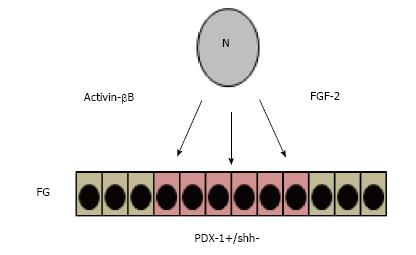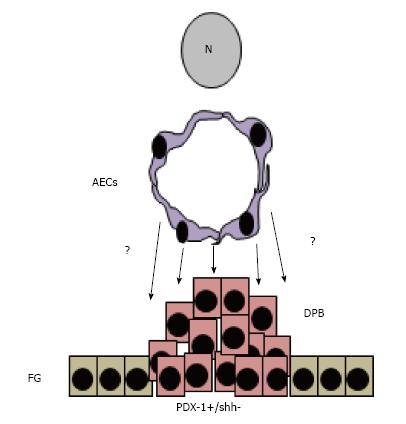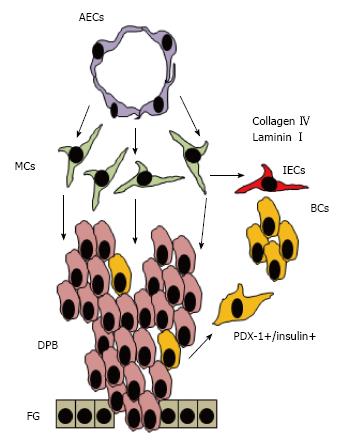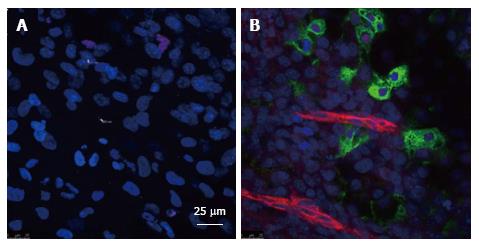Copyright
©The Author(s) 2015.
World J Exp Med. May 20, 2015; 5(2): 40-49
Published online May 20, 2015. doi: 10.5493/wjem.v5.i2.40
Published online May 20, 2015. doi: 10.5493/wjem.v5.i2.40
Figure 1 Early cell-cell interactions that give rise to pancreatic cells derived from definitive endoderm of the foregut (FG).
Factors released by notochord (N) such as activin-βB and FGF-2 permit expression of PDX-1 and suppress expression of sonic hedgehog. FGF: Fibroblast growth factor; PDX: Pancreatic and duodenal homeobox.
Figure 2 Endothelial-derived signals maintain expression of PDX-1 and promote pancreatic endocrine differentiation.
Once the aorta is forming, aortic ECs (AECs) interact closely with FG/DE cells that maintain expression of PDX-1 and form the dorsal pancreatic bud (DPB). ECs: Endothelial cells; DE: Definitive endoderm; FG: Foregut; PDX: Pancreatic and duodenal homeobox.
Figure 3 Endothelial-derived signals promote the survival of pancreatic mesenchyme which is essential for pancreas development.
Mesenchymal cells (MCs) appear between AECs and the dorsal pancreatic bud (DPB) and promote proliferation and survival of differentiated cells. Immature beta cells (BCs) that co-express PDX-1 and insulin migrate toward the mesenchyme and form cell clusters that will become islet of Langerhans that will recruit ECs that become islet ECs (iECs) and produce collagen IV and laminins which promote insulin expression. AECs crosstalk with MCs and maintain the integrity of these cells toward adequate exocrine and endocrine pancreas development. AECs: Aortic ECs; ECs: Endothelial cells; PDX: Pancreatic and duodenal homeobox.
Figure 4 Analysis of blood vessels and insulin-producing cells in embryoid bodies obtained from human embryonic stem cell line H9.
Human embryonic stem cells were cultured in suspension for 5 d to obtain embryoid bodies (EB). After attachment on coverslips for 24 h. Some EBs were cultured alone or together with human microvascular endothelial cells (HMECs). Then, after 20 d both groups of EBs were fixed and stained with with anti-proinsulin (green) (a marker for pancreatic beta cells), anti-CD31 (red) (a marker for endothelial cells), and DAPI (blue) (that stains the nuclei). A: EB cells cultured alone that do not show proinsulin or CD31 expression. In contrast with (B) EB cells co-cultured with HMECs at passage 14 in which we can find cells that express proinsulin in close proximity to cells that express CD31. HMECs did not stain positive for CD31 at the dilutions used indicating that the ECs are forming within EBs.
Figure 5 Diagram that explains the possible effects of external Endothelial cells toward in vitro beta-cell differentiation in human embryoid bodies.
?: Unknown factors, differentiation steps, or cell lineages; BMPs: Bone morphogenetic proteins; EC: Endothelial cells; EB: Embryoid bodies; BC: Beta cells; OCL: Other cells lineages; MC: Multipotent cell.
- Citation: Talavera-Adame D, Dafoe DC. Endothelium-derived essential signals involved in pancreas organogenesis. World J Exp Med 2015; 5(2): 40-49
- URL: https://www.wjgnet.com/2220-315X/full/v5/i2/40.htm
- DOI: https://dx.doi.org/10.5493/wjem.v5.i2.40













